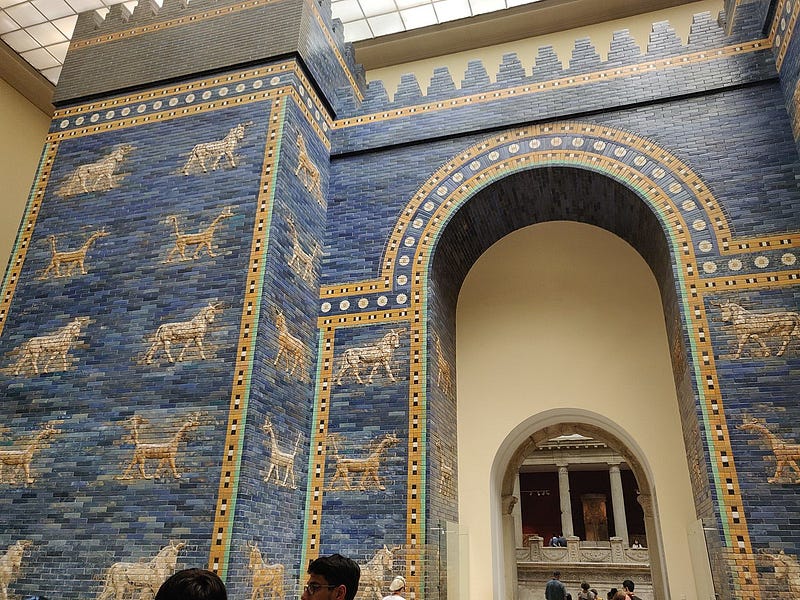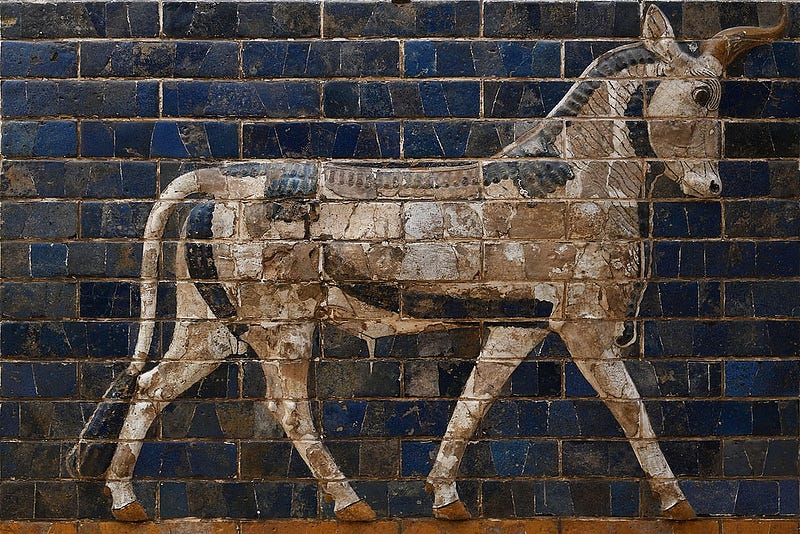Unveiling the Secrets of the Ishtar Gate: New Findings
Written on
Chapter 1: The Ishtar Gate Revisited
Recent investigations into the reconstructed Ishtar Gate of ancient Babylon have unveiled surprising new insights. Archaeologists now suggest that this iconic monument may have been built later than previously believed, potentially altering its historical significance.

[Photo: Rictor Norton, CC BY 2.0, via Wikimedia Commons]
The Ishtar Gate, a splendidly decorated city entrance in Babylon, is renowned for its vibrant blue-glazed bricks and intricate depictions of up to 575 animals, each representing various deities. Although the original structure did not survive to modern times, it has been reconstructed using genuine fragments. Today, the Ishtar Gate resides in the Pergamon Museum in Berlin.
Historically, it was believed that the gate was constructed during the reign of King Nebuchadnezzar II, who ruled from 604 to 562 BCE. The gate was dedicated to the goddess Ishtar and served as the northern gateway of the city, leading to the "processional way" that stretched to the E-sagila, the temple dedicated to the god Marduk. It was traditionally thought to have been erected to commemorate Nebuchadnezzar’s conquest of Jerusalem.
The Pergamon Museum, one of the world's most prestigious museums, closed for renovations last year, expected to last 14 years. This has provided an opportunity for an international team of scientists from Italy, Germany, and the United States to reexamine this monumental artifact during its closure.
"In our latest research, we analyzed the fired bricks used in the Ishtar Gate's construction, the entryway to ancient Babylon. We obtained reliable data about all three phases of the gate's construction, with the earliest phase featuring bricks inscribed with King Nebuchadnezzar II's name," the researchers noted in PLOS One.

[Photo: Kurt Kaiser, CC0, via Wikimedia Commons]
The researchers highlighted that the construction phases of the Ishtar Gate have long been debated. They acknowledged that earlier research methods might have been unreliable; for instance, radiocarbon dating often provides a broad time range rather than a specific date, which must then be narrowed down with additional archaeological evidence.
"Archaeological materials typically rely on radiocarbon samples, which can be uncertain by several hundred years. Even when charcoal associated with an archaeomagnetic sample is discovered, calibrating the radiocarbon age to the calendar age is not always straightforward," the authors explained.
To tackle the complex dating issue, the research team employed a different method. They extracted small samples from five fired bricks of the Ishtar Gate located in the Berlin museum and measured the magnetic field of each. This approach is known as paleomagnetic or archaeomagnetic dating.

[Photo: Dosseman, CC BY-SA 4.0, via Wikimedia Commons]
This method involves analyzing changes in the direction of the magnetic field and measuring the intensity and direction of the magnetic field within iron oxide particles that have been subjected to high temperatures. The aim is to assess the orientation and intensity of the magnetic field in undisturbed archaeological artifacts. The results are then compared with established tables of historical magnetic orientations in the area to achieve precise dating.
The study revealed that there were no significant chronological gaps between the various construction phases. Scholars contend that the first phase commenced merely three years after the Babylonian conquest of Jerusalem in 586 BCE. This event led to the destruction of the city and the first Jewish Temple, with many residents deported during the Babylonian exile.
"Given that all magnetic field measurements from the five fired bricks were consistent, we conclude that the gate was constructed around 583 BCE, aligning with Nebuchadnezzar II's reign, during which the order to build the gate was issued," the research team stated.
Scientists emphasize that at the time the gate was completed, Nebuchadnezzar II was still alive, which contradicts earlier beliefs that he died shortly after the initial phase was finished.
"The findings indicate that the Ishtar Gate maintained its architectural style throughout the construction process. We believe that the second and third phases are closely associated with the original design and represent the entirety of the construction process, rather than later modifications that might have altered the original structure," the authors concluded.
Thus, this new research raises the possibility that the Ishtar Gate was not constructed solely as a tribute to the Babylonians' military victory. Future studies will further illuminate the reasons behind its construction.
Chapter 2: The Sagrada Familia’s 140-Year Construction Saga
The Sagrada Familia is a marvel that captivates not only tourists in Barcelona but also anyone interested in architectural history.
Dear readers,
I want to address a challenge faced by content creators like myself on Medium.com. Despite our dedication to producing valuable content, the compensation often falls short. If you appreciate my articles, please consider supporting me on my "Buy Me a Coffee" page. Your contributions, no matter how small, can inspire me to keep creating engaging and thought-provoking material. Thank you for joining me on this journey!

